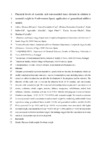Mostrar el registro sencillo del ítem
Placental levels of essential and non-essential trace element in relation to neonatal weight in northwestern Spain: application of generalized additive models
| dc.contributor.author | Álvarez-Silvares, Esther | |
| dc.contributor.author | Fernández-Cruz, Tania | |
| dc.contributor.author | Bermúdez-González, Mónica | |
| dc.contributor.author | Rubio-Cid, Paula | |
| dc.contributor.author | Almeida, Agostinho | |
| dc.contributor.author | Pinto, Edgar | |
| dc.contributor.author | Seoane-Pillado, Teresa | |
| dc.contributor.author | Martínez-Carballo, Elena | |
| dc.date.accessioned | 2023-11-20T11:35:08Z | |
| dc.date.issued | 2023-03-21 | |
| dc.identifier.citation | Álvarez-Silvares E, Fernández-Cruz T, Bermudez-González M, Rubio-Cid P, Almeida A, Pinto E, Seoane-Pillado T, Martínez-Carballo E. Placental levels of essential and non-essential trace element in relation to neonatal weight in northwestern Spain: application of generalized additive models. Environ Sci Pollut Res Int. 2023 May;30(22):62566-62578. | es_ES |
| dc.identifier.issn | 0944-1344 | |
| dc.identifier.uri | http://hdl.handle.net/2183/34295 | |
| dc.description.abstract | [Abstract] Adequate gestational progression depends to a great extent on placental development, which can modify maternal and neonatal outcomes. Any environmental toxicant, including metals, with the capacity to affect the placenta can alter the development of the pregnancy and its outcome. The objective of this study was to correlate the placenta levels of 14 essential and non-essential elements with neonatal weight. We examined relationships between placental concentrations of arsenic, cadmium, cobalt, copper, mercury, lithium, manganese, molybdenum, nickel, lead, rubidium, selenium, strontium, and zinc from 79 low obstetric risk pregnant women in Ourense (Northwestern Spain, 42°20'12.1″N 7°51.844'O) with neonatal weight. We tested associations between placental metal concentrations and neonatal weight by conducting multivariable linear regressions using generalized linear models (GLM) and generalized additive models (GAM). While placental Co (p = 0.03) and Sr (p = 0.048) concentrations were associated with higher neonatal weight, concentrations of Li (p = 0.027), Mo (p = 0.049), and Se (p = 0.02) in the placenta were associated with lower newborn weight. Our findings suggest that the concentration of some metals in the placenta may affect fetal growth. | es_ES |
| dc.language.iso | eng | es_ES |
| dc.publisher | Springer Nature | es_ES |
| dc.relation.uri | https://doi.org/10.1007/s11356-023-26560-x | es_ES |
| dc.rights | This version of the article has been accepted for publication, after peer review and is subject to Springer Nature’s AM terms of use, but is not the Version of Record and does not reflect post-acceptance improvements, or any corrections. | es_ES |
| dc.subject | Birth weight | es_ES |
| dc.subject | Metals | es_ES |
| dc.subject | Newborn weight | es_ES |
| dc.subject | Placenta | es_ES |
| dc.title | Placental levels of essential and non-essential trace element in relation to neonatal weight in northwestern Spain: application of generalized additive models | es_ES |
| dc.type | info:eu-repo/semantics/article | es_ES |
| dc.rights.access | info:eu-repo/semantics/embargoedAccess | es_ES |
| dc.date.embargoEndDate | 2024-03-21 | es_ES |
| dc.date.embargoLift | 2024-03-21 | |
| UDC.journalTitle | Environmental Science and Pollution Research | es_ES |
| UDC.volume | 30 | es_ES |
| UDC.issue | 22 | es_ES |
| UDC.startPage | 62566 | es_ES |
| UDC.endPage | 62578 | es_ES |
Ficheros en el ítem
Este ítem aparece en la(s) siguiente(s) colección(ones)
-
GI-GIRS - Artigos [94]







